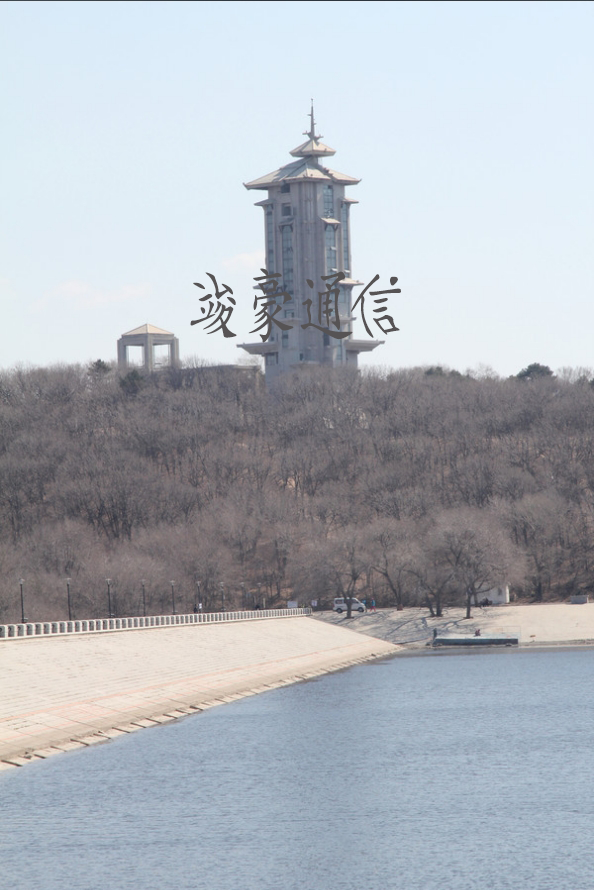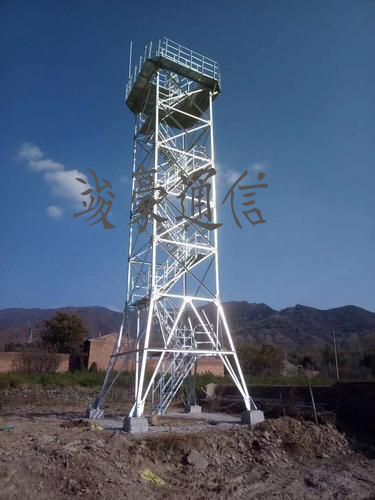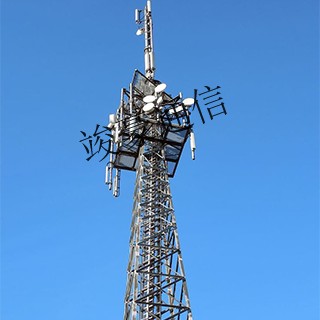Watchtower: A Legend of Guarding and Witnessing
一、The modern application of watchtowers

Maoxian Fire Prevention Watchtower
The two newly built fire prevention watchtowers in Maoxian are located in Songpinggou Village, Diexi Town and Qugu Village, Chibusu Town. These two watchtowers adopt a combination of manual observation and intelligent monitoring, providing strong support for forest and grassland fire prevention and control work.
The newly built watchtower has added wind and solar power generation equipment, effectively filling the gap of inability to monitor power outages and achieving 24-hour uninterrupted monitoring. This advanced monitoring method greatly enhances the comprehensive prevention and control capability of forest and grassland fires.
The special renovation project for the construction of fire prevention and extinguishing infrastructure in Maoxian Forest and Grassland has put the fire prevention watchtower into use, marking the transformation of Maoxian's forest and grassland fire prevention and extinguishing work from the previous single "civil defense" to the current precise protection mode combining "mountain patrol forest rangers (civil defense)+early warning monitoring system (technical defense)".
In order to fully utilize the role of the watchtower, each watchtower is equipped with four on duty personnel who take turns on duty, and corresponding management systems and job responsibilities have been established. This lays the foundation for achieving the goal of "early, early, and early" forest fires, making forest and grassland fire prevention and extinguishing work more standardized, scientific, and institutionalized.
Wushan Observation Tower
The Wushan Observation Tower in Hangzhou has a history of over a hundred years and was first built in the 33rd year of the Guangxu reign of the Qing Dynasty (1907). At that time, the Supervisor of the County of Renhe County raised money from the merchants and gentry, built a watchtower in front of the Yuemiao Temple in the east of Wu, and hung a copper bell as the signal bell of the fire alarm at that time.
This watchtower has undergone multiple renovations, from its initial wooden structure to a reinforced concrete structure in 1953, and now, with the opening of the Wushan Fire Rescue Station, it has been revitalized.
In history, Hangzhou was also a city with many fires. In order to prevent fires and provide disaster relief, during the Song Dynasty, the Hope Fire Tower was built at a high place according to regulations, and soldiers were on duty day and night. During the Chunyou period of the Southern Song Dynasty, there were more than ten watchtowers and over 5000 hidden fire soldiers both inside and outside the capital city of Hangzhou.
From the construction of the watchtower until the early days of liberation, the method of "sounding the alarm bell" was used to report fire alarms on the watchtower. According to records, the lookout identified a fire alarm based on the shape and color of the smoke, and sounded the emergency bell 20-30 times. Firefighters in various regions were prepared to release the fire. In the past, there were clear regulations for the fire alarm area: once the bell rang, it was from south of Hefang Street to Fengshan Gate; The second sound is from the north of Hefang Street to Yanqiao Street (Qingchun Road); The three sounds are from Yanqiao Street to Wulinmen; The four sounds are outside the Qiantang Gate; The five sounds refer to the outside of the Wulin Gate, as well as the Hu Shu and Gong Bu; The six sounds are Fengshan Gate and Houchao Gate; Seven sounds refer to the outside of Genshan Gate and Jianqiao Bridge; The Eight Sounds represent Wangjiangmen, Qingtaimen, and Taipingmen.
In 1951, the first telephone was installed in the watchtower, and the alarm bell was rung to exit the historical stage. Afterwards, the watchtower was equipped with high-powered telescopes, walkie talkies, and other devices. Nowadays, the Wushan Fire Rescue Station is responsible for the primary fire warning, extinguishing, and emergency rescue tasks of the entire Wushan Scenic Area.
A hundred years later, the Wushan Observation Tower installed multiple video surveillance devices at the top of the tower, equivalent to using the Tianyan system for inspection. Once a fire alarm occurs, immediate positioning and magnification shooting can be carried out. Through thermal imaging equipment, the specific location of the fire can be confirmed in the first time, and the information can be provided to frontline firefighters and the rear command platform, which can effectively enhance the fire warning capability of the jurisdiction.
The East China Sea Observation Tower
China recently launched an ocean observation building with an altitude of over 100 meters and a weight of 4500 tons, which will become the tallest ocean observation facility in China. This ocean observation building is located in the East China Sea and is expected to be completed by mid month.
The observation platform is named "Tongji Haiyang-1" and is constructed by China National Offshore Oil Engineering Corporation. It will be equipped with at least 195 sets of observation equipment for collecting environmental and marine data. It will conduct real-time and high-resolution three-dimensional observations of the atmosphere, hydrosphere, and lithosphere, continuously monitor environmental data, provide key oceanographic big data for climate change research, and serve as a marine disaster warning system.
The construction of this observation tower is not only for scientific research, but will also help safeguard China's maritime rights and promote the development of the marine economy. The project manager of CNOOC Engineering Company stated that the platform will be equipped with the most monitoring sensors in China's marine structures and operate as an intelligent device, adopting digital risk control and maintenance procedures.
This observation platform is an important component of the first national major scientific and technological infrastructure project in China's marine field, the "Underwater Science Observation Network". The project was approved by the National Development and Reform Commission in March 2017 and jointly led by Tongji University and the Institute of Acoustics of the Chinese Academy of Sciences, aiming to establish a submarine scientific observation network in the East China Sea and the South China Sea.
二、The historical significance of the watchtower

Hangzhou Wushan Observation Tower
The Wushan Watchtower in Hangzhou was first built in the 33rd year of the Guangxu reign of the Qing Dynasty, and its historical significance is significant. It has witnessed the transformation of fire prevention and control in Hangzhou city, from the initial wooden tower structure, which relied solely on lookout to distinguish the shape and color of smoke and sound the alarm, to now equipped with advanced video surveillance equipment and the "Wushan Tianyan system".
During the Song Dynasty, Hangzhou built the Hope Fire Tower, which was built on a high ground according to regulations and had soldiers on duty day and night. During the Chunyou period of the Southern Song Dynasty, there were more than ten watchtowers and over 5000 hidden fire soldiers inside and outside Hangzhou, which reflected the importance people attached to fire prevention and control at that time. The Wushan Observation Tower was built with the advantage of Wushan's geographical location, and after completion, a copper bell was hung as a signal bell for fire alarms. Since then, it has become an important facility for fire warning in Hangzhou city.
In 1951, the first telephone was installed in the watchtower, and the alarm bell was rung to exit the historical stage. Afterwards, the watchtower was equipped with high magnification telescopes, walkie talkies, and other devices, constantly keeping up with the times. During the 2016 Hangzhou G20 Summit, the Wushan Observation Tower was briefly put into use to cooperate with the security of the summit. Now that the brand new Wushan Fire Rescue Station has entered the watchtower, this century old watchtower has a new mission. The Wushan Fire Rescue Station is responsible for the primary fire warning and emergency rescue tasks of the entire Wushan Scenic Area, and has given a new meaning to "watching the fire on Chenghuang Mountain".
Baoshan "Observation Tower"
The "Observation Tower" in Baoshan District is located in Miaoxing Town and was originally a fire and theft prevention facility for a cotton warehouse. It witnessed the changes on both sides of Shuzaobang, reflecting a profound sense of historical sedimentation.
This was originally the largest cotton warehouse in the Far East. To ensure safety, this "watchtower" was built near the river. Nowadays, although it has completed its historical mission, it has become a "popular check-in spot" with a new posture of historical relics.
Miaoxing Town was once the main battlefield of the "128" Songhu Anti Japanese War. On this land that carries red memories, the "Watchtower" has witnessed the tremendous changes on both sides of the Baoshan Mother River - Laozaobang for many years. It is adjacent to Gate 1 of the Intelligence Park, complementing the Science and Technology Innovation Reception Hall of No.1 Bay, and also complementing the construction of the "River of Science and Technology Innovation" in Laozaobang. It has become an "image ambassador" witnessing the economic development and technological takeoff of this region.
三、What are the famous watchtowers

The globally renowned watchtower
There are many famous watchtowers around the world, each with its unique features and design highlights.
• The Phoenix Observation Tower in the United States: Standing 420 feet tall and covering an area of 70000 square meters, it will add a structure to accommodate Phoenix antennas, allowing people to fully enjoy the spectacular scenery of the city. This watchtower is a symbol of Phoenix, the climax of the skyline, providing visitors and citizens with a place to enjoy the surrounding mountains and sunset scenery. Its shape is a large ball landing on a concrete column, with a glass curtain wall shell and an internal spiral ramp connecting the elevator and the top. People can travel along the spiral ramp and enjoy the 360 degree beauty of the city.
• The Bavarian Watchtower in Germany has a high altitude and elegant pedestrian walkway design. The total length of the structure is 1300 meters, with a height of 25 meters, featuring a dome and a spiral staircase, making it one of the most popular attractions in the Bavarian National Park.
• The observation tower of Daewon Park in Seongnam, South Korea: designed by Korean architect Changki for Seongnam City, South Korea.
• Wind turbine watchtower: aimed at eliminating toxic coal-fired power generation, implementing a new concept of future power generation, and making society cleaner. Having five arched blade models that can activate wind power, rotating in different directions to generate electricity, and illuminating buildings at night. At the same time, tourists are allowed to take walks around and enjoy the beautiful scenery.
• The observation tower on the surface of the Mur River in Austria: built on the border between Austria and Slovenia, with a double helix aluminum composite staircase.
• Guangzhou Tower in China: A spiral shaped skyscraper reaching up to 600 meters high, with an outdoor public observation deck on the roof about 488 meters high. Its perfect hourglass shape attracts tourists from all over the world. By setting up tracks on the roof, visitors can tour the entire area in 20 to 40 minutes.
• The ArcelorMittal Tower in London, England: The spiral tower has now been completed in London and is considered an art piece related to the Olympics, providing visitors with information about the Olympics. 60% of the steel used in the construction is recycled, and the height is nearly 114.5 meters.
• The Salford Watchtower in Norway: In 2008, the local town decided to build an all wooden watchtower to help people better explore the charm of nature and experience it.
• Amazon Bamboo Grove Observation Tower: British architect Marx Barfield designed a research center on Amazon bamboo forests and specifically built a bamboo grove observation tower with a spiral ladder. The center will allow two researchers and tourists to investigate the rainforest canopy.
• The N ä sinneula Observation Tower in Finland: Built in 1970, the tower stands at a height of 168 meters and is the tallest self standing structure in Finland and the tallest observation tower among Nordic countries.
The Italian Coastal Watchtower
Italy has many beautiful coastal watchtowers, which not only have historical value, but also add unique scenery to the coast.
• Scola Tower: Located in the port of Venere, Liguria, the pentagonal building dates back to the late 16th century and is sometimes referred to as the "Tower of John the Baptist". In 1800, the cannon fire of the battle between the British and Napoleon's fleet made it what it is today. Once stationed ten soldiers, equipped with ten cannons, built by the Republic of Genoa for coastal defense.
• Asturata: located in Tuno, Lazio region, built by the Frangipani family in the late 12th century. Located in the sea, it is connected by a narrow and long arched wharf, resembling a small brick castle with wall piers. It is said that in 1228, King Conradin of Swabia of Sicily was imprisoned here.
• Paulo Tower: located at the southernmost tip of the Sabadia Beach at Cape Chilchio on the coast of Lazio, it was built by Pope Pius IV in 1563. It is a tenacious fortress that has resisted foreign invasions multiple times in history. Fortunately, it did not suffer serious damage in battle and is now waiting for renovation.
• Squilacheta: Located on the Ionian coast between Nardo and Caesar Harbor in the Apulia region, it is one of the more than 80 watchtowers in the Salento area. The square building was designed by Pecino Tarantino and built between 1567 and 1570 after the Turkish invasion of Otranto in 1480.
• Pizota: Built by Charles V in the 16th century in the beautiful Gallipoli Bay of the Ionian Sea in the Apulia region. Nature surrounds this white tower, making this coast one of the most beautiful areas in Puglia.
• Parrita: South Salento, a circular flat tower that used to be on land and is now located about 20 meters offshore in the sea. It is also one of the watchtower families built between the 16th and 18th centuries to face the threat of the Ottoman Empire.
• Vadota: Less than ten kilometers from Parrita and not far from Santa Maria di Leiuka. Usually equipped with a messenger on horseback, ready to depart at any time to inform the people inland of the enemy situation.
• Merisata: located on the Ionian coast in the province of Croto, Calabria, in the municipality of the same name. There is now a museum and a local gourmet restaurant inside the building, as well as beautiful views of Corona Point and Chilomarina, located near Taranto Bay, about 60 kilometers away.
• Mandreta: Altavira Militia in the city of Palermo, Sicily, also known as the "Norman Tower", can actually be traced back to the rule of the Kingdom of Aragon in the second half of the 16th century. Used to defend against North African pirates, overlooking the small and spectacular grandmother green bay.
• Plezemorota: located in San Ilya, Cagliari, Sardinia, built in the 16th century. Also known as the "Cara Bernat Tower" or "Infectious Disease Hospital Tower", it is considered a "secondary" tower because it has never been equipped with military force and is only used for territorial control, providing a clear view of up to 20 kilometers.
四、Design features of the watchtower

Fire resistant watchtower design
Fire prevention watchtowers play a crucial role in forest fire prevention. Taking the fireproof observation tower as an example, it has the characteristic of occupying a small area and can play the maximum role in a limited space, saving land resources. Transportation and installation are also very convenient, with a light weight of the tower body, making it easy to transport to inconvenient transportation areas such as mountainous areas for installation, greatly shortening the construction period. At the same time, its structure is safe and reliable, and its design complies with the national steel structure design specifications and tower and mast design regulations.
Building towers in mountainous areas has many benefits. Firstly, by building two fire-resistant observation towers in the mountainous area, one can have a panoramic view of the entire mountain from a high vantage point, eliminating blind spots and saving a lot of manpower. With a fixed watchtower, forest rangers can observe indoors, which not only protects them from wind, sun, and cold, but also allows them to concentrate on forest fires. Building a good fire prevention watchtower can better reflect the forest fire prevention work policy of "prevention first, active elimination", ensure the safety of people's lives and property, and protect the forest resources in mountainous areas.
Design characteristics of watchtowers in different regions
The watchtower of the Kingdom of Sardinia in Italy is unique in design and function due to its geographical environment. The Kingdom of Sardinia is located in the Mediterranean region, with rich and diverse geographical features and unique environmental conditions. It has a rich coastline, intricate coastal edges, a central mountain system, vast sea areas, and diverse ecosystems.
Observation towers are often built on high ground, such as mountaintops, ridges, or headlands, to overlook the surrounding area and provide a broader view and observation range. In the Kingdom of Sardinia, watchtowers may be built on central plateaus surrounded by mountains or on coastal highlands to better observe maritime activities and navigation conditions.
Observation towers are usually located near transportation arteries, such as road intersections, rivers, or ocean channels, and are used to observe and monitor pedestrians, vehicles, ships, etc. In the Kingdom of Sardinia, due to the importance of its geographical location, the watchtower's position on transportation arteries is even more prominent, becoming an important navigation tool and safety monitoring point.
In military strategy, watchtowers are usually built in strategically significant locations such as borders, fortresses, or coastlines to provide better defense and surveillance capabilities, protecting national borders and important facilities. As an island nation, the Kingdom of Sardinia's watchtowers hold significant strategic importance in areas such as borders and coastlines.
In addition, watchtowers may also be built in potential risk areas such as earthquake zones, volcanic areas, or marine disaster prone areas to monitor and warn of potential natural disasters, and take timely measures to protect people's lives and property. The Kingdom of Sardinia is located in the Mediterranean region and is often affected by earthquakes and other natural disasters, making the role of watchtowers even more important in these areas.
The weather conditions in the region also have a significant impact on the observation and monitoring functions of the watchtower. The Kingdom of Sardinia has a Mediterranean climate, with hot and dry summers and warm and humid winters, and may often experience severe weather conditions such as dense fog. When designing and constructing watchtowers, it is necessary to consider their stability and durability to ensure their reliability under various weather conditions.
Some watchtowers may be located in places with special cultural and historical backgrounds. In the Kingdom of Sardinia, watchtowers not only serve the functions of observation and surveillance, but also emphasize and inherit the local history and cultural traditions, becoming cultural heritage and tourist attractions, attracting tourists and researchers to visit and study.




